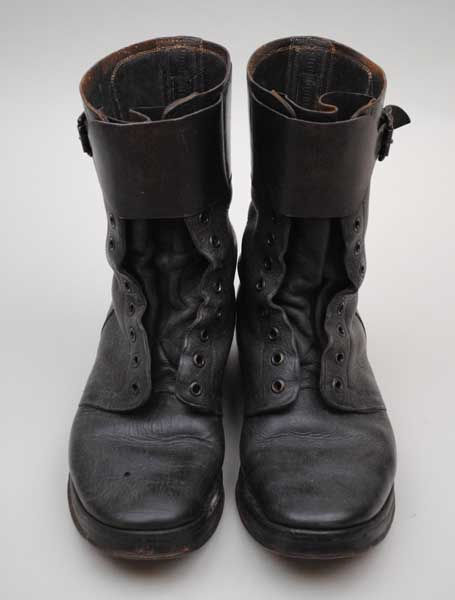
The Second War Generation (1940-1950)Wesley Alkenbrack's D-Day Boots |
|||
|
|||
Boots worn at Bernieres-sur-Mer, as part of Operation Neptune
|
Born on a farm just west of Napanee, as the First World War was drawing to a close, Wesley Alkenbrack enlisted as a young man of 22, in the 32/43 Field Regiment , R.C.A. on June 8, 1940. He served overseas with the 34th Field Regiment R.C.A. DISCOVER MORE![]()
Wes landed at Bernieres-sur-Mer, Normandy, France on June 6, 1944, part of Operation Neptune, the first Allied amphibious assault wave to establish Allied Forces in Normandy. The boots and uniform that he wore during this landing all survived, as did his mess kit and duffel bag. The boots have been restored by a conservator, and although the soles are well worn, the boots themselves are in good condition considering the action they saw.
The Normandy invasion began with overnight parachute and glider landings, air attacks and naval bombardments. In the early morning hours, amphibious landings on five beaches, code named Juno, Gold, Omaha, Utah, and Sword, were underway. During the evening the remaining elements of the parachute divisions landed. The "D-Day" forces deployed from bases along the south coast of England.
Allied forces rehearsed their roles for D-Day months before the invasion. Operation Overlord was the code name for the Allied invasion of northwest Europe. The assault phase of Operation Overlord was known as Operation Neptune. Operation Neptune began on D-Day (6 June 1944) and ended on 30 June 1944. By this time, the Allies had established a firm foothold in Normandy. Operation Overlord also began on D-Day, and continued until Allied forces crossed the River Seine on 19 August 1944.
Wes wrote of his experience:
Having made it from the beach, our problem now was to get into the town and to get into the open countryside … The batteries had become mixed up on the beach … we were not complete as units, it was just anyone who could get there first. Suddenly, there was an order for four guns to go into a field right beside the town where we could support the Chaudieres. I was the fourth gun. We turned around a high corner of a Normandy wind-wall.
The troop commander was out in the field, giving directions by arm – waving his arms, appointing the positions for the guns. And we started in a wide arc of a circle; number one gun, number two, number three and my own gun, number four. Just as my own gun, number four, was coming around the corner of this wind-wall, there was a high scream of steel meeting steel, and the first gun was hit. It wasn’t destroyed; smoke was rising from the gun, and it had stopped, of course, by then, and we could see the crew jumping out of it. There would be probably seven or eight men on the gun crews. That was the first blow that the Regiment took. …. We were extremely vulnerable to enemy fire … our tanks had been utilized to carry explosives which were surplus to our needs; we were carrying ammunition and explosives for other units. We were just a moving bomb in ourselves, each gun, as it stood.
The first gun had been hit by a German 88 which was the deadliest weapon that anybody possessed throughout the war in northeast Europe. The crew of the number one gun had been spared because the shell had not hit the dangerous pay-loads that each gun carried. At that moment, number two gun was struck by the second round fired by the 88. It, too, began to smoke. We could see the crew leaping out and they survived. … Moments later, Number three gun, which was right in front of me, was hit. And this time, the 88 had scored the big one. He put a round through the pay-load of explosives that the vehicle was carrying. There was a solid sheet of flame, hideous flame, that probably went hundreds of feet into the air as the whole gun – vehicle, gun tank – exploded. There was no smoke afterwards. The explosion was too complete for any smoke afterwards … there was not a trace of the eight men who had stood on the deck of that vehicle when the disaster hit.
We were the fourth gun. We stopped when the tremendous blast wave of the explosion of number three had struck us. We were in such a shock that we were literally transfixed there and paralysed. As we stared ahead of us, speechless, I heard a voice from behind me shouting, “Alkenbrack, get back out of there.” It was our own troop commander behind he us. He didn’t have to tell me twice.”
Wes remained in Europe through 1945-1946, serving with the Canadian Army Staff lines of Communication, with postings in Ghent, Brusells and Paris. He was discharged June 19, 1946.
© Lennox & Addington County Museum & Archives
97 Thomas Street East, Napanee, Ontario, Canada K7R 4B9
Funding provided by the Government of Ontario and the County of Lennox & Addington




